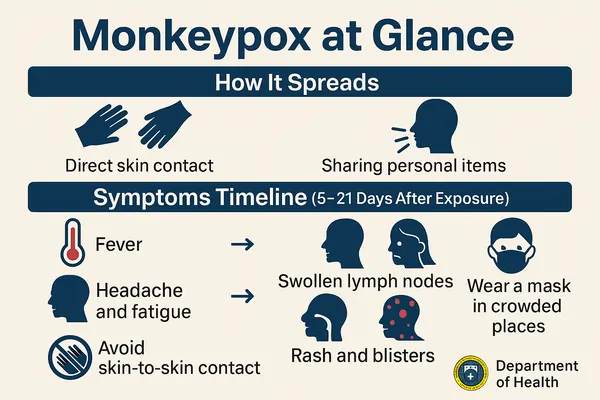
Monkeypox Cases Rise in the Philippines: Health Officials Issue Warning
Monkeypox cases are rising across different parts of the Philippines, prompting health authorities to issue fresh safety reminders. The virus, though not new, is gaining attention due to its increasing spread and health risks.
What the DOH Has Confirmed
The Department of Health (DOH) recently confirmed a noticeable surge in monkeypox infections in both urban and rural regions. This includes clusters of cases in Metro Manila, Central Luzon, and parts of Visayas.
Why This Matters to the Public
Unlike common illnesses, monkeypox can spread through close physical contact and contaminated items, which means it can easily affect households, workplaces, and schools. The rising cases show the urgent need for preventive habits and early detection.
What Experts Are Advising Now
Health experts are calling on communities to stay informed, avoid panic, and act early. Following basic hygiene, avoiding contact with people showing symptoms, and seeking help when needed can make a big difference in stopping the spread.
Understanding Monkeypox and Its Threat
Monkeypox cases are becoming a growing concern in the Philippines as infections gradually increase in various regions. While the disease is not new, its recent resurgence highlights the importance of awareness and early action.
This viral illness produces clear symptoms that can disrupt daily life and pose risks to families and communities if not properly managed.
What Is Monkeypox?
Monkeypox is a viral disease that typically starts with fever, tiredness, and body aches. A few days later, a rash appears, often beginning on the face before spreading to other parts of the body.
Painful blisters and swollen lymph nodes are also common, helping doctors differentiate it from similar illnesses like chickenpox or measles.
How It Spreads
Although less contagious than COVID-19, monkeypox cases can spread through:
- Direct skin-to-skin contact with an infected person
- Touching items like clothing, towels, or bed sheets that carry the virus
- Face-to-face interaction that allows droplets to pass between people
This makes it a particular risk in crowded homes, workplaces, and public spaces.
Monkeypox in the Philippines: A Timeline
The first monkeypox case in the Philippines was reported in mid-2022. Since then, the Department of Health has kept a close watch. In recent weeks, the country has seen a significant rise in monkeypox cases, especially in highly populated areas.
Health officials believe that limited awareness, high mobility, and delayed reporting are contributing to the increase.
Recent Developments and Confirmed Cases
The rise in monkeypox cases has drawn national attention, with new infections spreading in key areas across the Philippines. Health authorities are taking urgent steps to manage the situation and prevent further escalation.
Areas With the Highest Case Numbers
The Department of Health (DOH) has reported over 80 new monkeypox cases in the past two weeks alone. The majority of these were recorded in Metro Manila and Central Luzon, where population density and daily movement are high.
Government Response in Action
Health Secretary Dr. Liza Vergara has directed all Local Government Units (LGUs) to improve community surveillance, educate residents, and ensure access to hygiene resources. Isolation units in hospitals are being prepared to handle both suspected and confirmed patients quickly.
“The public must report symptoms early and avoid stigmatizing those affected. Prevention and education are our strongest tools,” Dr. Vergara emphasized.
Urgency Behind the Precautionary Measures
Hospitals have been placed on high alert to handle potential surges. The DOH is also coordinating with local officials to roll out information campaigns and distribute protective supplies to high-risk communities. Officials believe that quick action and public cooperation are key to containing the spread of monkeypox cases.
How the Virus Spreads
To better understand the recent rise in monkeypox cases, it’s important to learn how the virus moves from person to person. Though not as airborne as COVID-19, monkeypox can still spread in ways that are common in daily life—especially in close communities.
Direct Skin Contact
The virus spreads easily through skin-to-skin contact with an infected individual. This includes contact with rashes, blisters, or bodily fluids—often before symptoms become obvious.
Contaminated Items
Touching infected materials, such as clothing, towels, or bedsheets, can lead to infection. These items may carry the virus if they’ve been in contact with a person who has active lesions or sores.
Respiratory Droplets
Although monkeypox does not travel far through the air, prolonged face-to-face contact—like conversations, coughing, or sneezing in close quarters—can transmit respiratory droplets that carry the virus.
Intimate Physical Contact
Intimate activities, including kissing or sexual contact, carry a high risk. Health officials have noted that many recent monkeypox cases stem from such close interactions.
Even if the virus isn’t airborne in the traditional sense, prolonged close contact with infected individuals still poses a serious risk—especially in shared spaces like homes, workplaces, or public transport.
What Filipinos Can Do to Stay Safe
With the number of monkeypox cases rising in the country, health authorities are emphasizing the importance of preventive habits. Staying informed and making small changes to everyday routines can greatly reduce the risk of infection.
Avoid Close Contact
It is best to stay away from anyone showing signs of illness—especially those with visible rashes or flu-like symptoms. Even simple physical contact, like hugging or handshakes, can increase the risk.
Practice Proper Hygiene
Washing hands frequently with soap and water or using alcohol-based hand sanitizers helps eliminate germs. This is one of the most effective defenses against infection.
Don’t Share Personal Items
Avoid using or borrowing items like utensils, towels, grooming tools, or bed linens that may have been in contact with someone infected. These objects can carry the virus and unknowingly spread it to others.
Wear a Mask in Crowded Areas
Wearing a face mask is still helpful—especially in indoor spaces or during long exposure to crowds. It adds an extra layer of protection, particularly in areas with confirmed monkeypox cases.
Seek Help When Symptoms Appear
If you or someone in your household experiences symptoms such as fever, fatigue, body pain, or skin rashes, consult a doctor or visit the nearest health center immediately. Early detection can prevent the virus from spreading further.
What to Do If You Suspect Infection
In light of rising monkeypox cases in the Philippines, knowing how to respond if you suspect exposure is critical. Early action not only protects you but also helps prevent the virus from spreading within the community.
Isolate Right Away
Anyone who experiences symptoms—such as fever, swollen lymph nodes, or skin rashes—should self-isolate immediately. Avoid contact with family members or others until you’ve been assessed by a medical professional.
Contact Health Authorities
Reach out to your local health center or barangay health unit for guidance. They will assess your symptoms and provide the next steps, including whether testing is needed.
Follow Testing and Quarantine Guidelines
If advised, undergo a monkeypox test and follow quarantine procedures carefully. Stay at home and limit movement to reduce the chance of spreading the virus, especially in areas where monkeypox cases have already been reported.
Use Available Hotlines
The Department of Health (DOH) has activated hotlines in key regions to help anyone who has symptoms or concerns. These lines offer quick guidance and referrals for medical care and testing.
Government Response and Next Steps
As monkeypox cases continue to rise, the Philippine government is stepping up efforts to control the situation and keep the public informed and protected.
Coordinated National Efforts
The Department of Health (DOH) is actively working with local government units (LGUs), health centers, and international health organizations to track the spread of the virus. Regular updates are being shared to keep the public aware of current risks and safety measures.
Education and Awareness Campaigns
To ensure that communities understand the risks, educational materials are being distributed in schools, public spaces, and online platforms. These materials include symptoms to watch for, preventive tips, and instructions on what to do if exposed to a confirmed case.
Funding, Vaccines, and Tracing
The government has allocated additional resources to support vaccination drives (where available), improve contact tracing, and strengthen the healthcare system’s response to monkeypox cases. Regional health units are being provided with the tools and support needed to manage possible outbreaks.
Call for Public Cooperation
Health experts stress that early reporting, public cooperation, and avoiding misinformation are essential. Communities that stay informed and follow safety guidelines can help reduce the spread and avoid overwhelming local healthcare facilities.
Conclusion
The recent rise in monkeypox cases across the Philippines is a reminder that public health requires both awareness and action. By staying informed, practicing good hygiene, and cooperating with local health authorities, every Filipino can play a part in stopping the spread. Early detection and responsible behavior are the strongest defenses we have.
Frequently Asked Questions (FAQs)
What are the first signs of monkeypox?
Early symptoms include fever, fatigue, body aches, swollen lymph nodes, and rashes that develop into blisters.
Is monkeypox deadly?
Most monkeypox cases are mild and treatable. However, complications can occur, especially for people with weak immune systems.
Can children catch monkeypox?
Yes. Children, along with the elderly and immunocompromised, are more vulnerable to the virus and should be protected.
Is there a cure or vaccine for monkeypox?
There is no specific cure, but antiviral medications and supportive care help manage symptoms. Some smallpox vaccines may offer protection, but availability is limited.
Should I be worried if there are monkeypox cases in my area?
Stay alert, not alarmed. Follow preventive measures, monitor symptoms, and report any concerns to your local health unit.
Disclaimer
This article is based on publicly available information as of May 27, 2025. For the latest updates, health guidelines, and emergency contact numbers, please visit the official websites of the Department of Health (DOH) and the World Health Organization (WHO).
📚 Resources
🇵🇭 Department of Health (DOH) Philippines
- Monkeypox Public Advisory
- Surveillance & Management Guidelines (PDF)
- DOH Memorandum 2024-0306
- RITM – Testing & Research Center
🌐 World Health Organization (WHO)
🧾 Educational Materials
- PSMID Mpox Infographics
- PSMID Official Site

Bianca Marie Reyes, aka Tita BoomBi, is a 30-year-old Filipina content creator who turns everyday chika into real talk and real-time news. Known for her witty takes and no-fake-news style, she breaks down viral stories, headlines, and public updates into fun, bite-sized content for the digital Filipino. She’s your online tita, always tuned in and always telling it like it is. With a mix of humour and honesty, she keeps things relevant, relatable, and 100% not fake.
